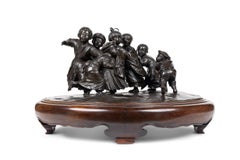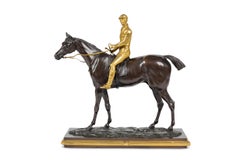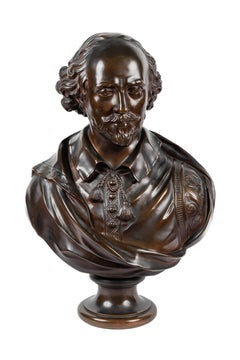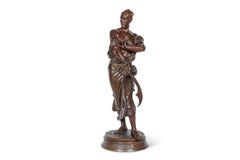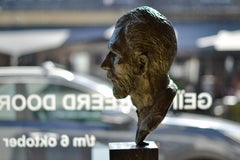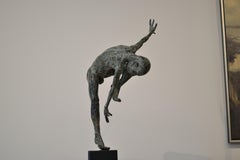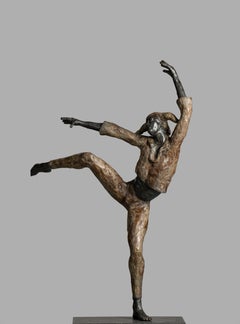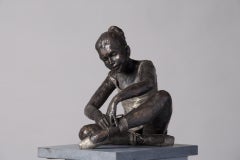a_15423982
Items Similar to A Massive Japanese Patinated Bronze Sculpture of a Tiger, Meiji Period
Want more images or videos?
Request additional images or videos from the seller
Want more images or videos?
Request additional images or videos from the seller
1 of 11

UnknownA Massive Japanese Patinated Bronze Sculpture of a Tiger, Meiji Period19th Century
19th Century
$18,000
Shipping Retrieving quote...
The 1stDibs Promise:
Authenticity Guarantee,
Money-Back Guarantee,
24-Hour Cancellation
Return Policy: A return for this item may be initiated within 7 days of delivery.

About the Item
A Massive Japanese Patinated Bronze Sculpture of a Tiger, Meiji Period. Signed.
Measuring an impressive 44 inches in length, this extraordinary sculpture is a striking example of the grandeur and craftsmanship characteristic of the Meiji era (1868–1912). Most certainly one of the largest models of its kind, this sculpture exudes power and grace, capturing the essence of the tiger with remarkable realism and dynamic posture.
The meticulously detailed musculature, fierce expression, and finely textured fur showcase the superior artistry of Japanese metalwork. The rich patina adds depth and dimension, enhancing its lifelike appearance.
This sculpture is not just a captivating work of art but also a testament to the skill and dedication of Meiji-period artisans, making it an exceptional acquisition for collectors of fine Asian antiques and animalier bronzes.
Signed on the bottom by artist with Japanese seal.
15" high x 44" wide x 18" deep
Very good condition, normal wear consistent with age and use. Ready to place.
- Creation Year:19th Century
- Dimensions:Height: 15 in (38.1 cm)Width: 44 in (111.76 cm)Depth: 18 in (45.72 cm)
- Medium:
- Period:
- Condition:
- Gallery Location:New York, NY
- Reference Number:1stDibs: LU1151215423982
About the Seller
5.0
Vetted Seller
These experienced sellers undergo a comprehensive evaluation by our team of in-house experts.
Established in 1980
1stDibs seller since 2019
13 sales on 1stDibs
Typical response time: <1 hour
- ShippingRetrieving quote...Ships From: New York, NY
- Return PolicyA return for this item may be initiated within 7 days of delivery.
Authenticity Guarantee
In the unlikely event there’s an issue with an item’s authenticity, contact us within 1 year for a full refund. DetailsMoney-Back Guarantee
If your item is not as described, is damaged in transit, or does not arrive, contact us within 7 days for a full refund. Details24-Hour Cancellation
You have a 24-hour grace period in which to reconsider your purchase, with no questions asked.Vetted Professional Sellers
Our world-class sellers must adhere to strict standards for service and quality, maintaining the integrity of our listings.Price-Match Guarantee
If you find that a seller listed the same item for a lower price elsewhere, we’ll match it.Trusted Global Delivery
Our best-in-class carrier network provides specialized shipping options worldwide, including custom delivery.More From This Seller
View AllA Monumental Gilt-Lacquered Bronze Ornamental Sculpture of Vajrasattva
Located in New York, NY
A Monumental Gilt-Lacquered Bronze Ornamental Sculpture of Vajrasattva:
A Masterpiece of Sino-Tibetan Craftsmanship, Late 19th Century, Qing Dynasty
This monumental gilt-lacquered bronze ornamental sculpture of Vajrasattva is an extraordinary and commanding piece of art, showcasing the pinnacle of Sino-Tibetan craftsmanship from the late 19th century. The figure of Vajrasattva, one of the most revered deities in Tibetan Buddhism, is meticulously sculpted to embody both spiritual power and artistic excellence.
Traditionally representing the bodhisattva of purification and meditation, Vajrasattva is usually depicted holding a bell in one hand and a vajra in the other, symbols of wisdom and method. However, in this striking sculpture, Vajrasattva is shown holding a vishva vajra (the double vajra), a unique and powerful variation of the traditional iconography, which adds a layer of depth and significance to the piece.
Vajrasattva: The Symbol of Purification and Divine Power
Vajrasattva is widely recognized in Tibetan Buddhism for his role in purification, his indestructible nature symbolized by the vajra, or "diamond scepter," that he typically holds. Traditionally, this tool represents both the clarity of wisdom and the power to destroy ignorance. In this sculpture, however, Vajrasattva holds the vishva vajra, the double vajra, which represents a heightened state of duality and balance in Buddhist philosophy. This variant of the vajra symbolizes the union of wisdom and compassion, a core tenet of the Tibetan Buddhist path to enlightenment.
The figure’s posture and serene expression suggest a state of calm contemplation and spiritual power. His stance, along with the carefully sculpted details of his robes and jewelry, emphasizes his elevated status within the Buddhist pantheon. The inclusion of the vishva vajra rather than the usual single vajra speaks to the artist’s sophisticated understanding of the deeper metaphysical meanings and the spiritual completeness that Vajrasattva embodies.
Symbolism of the Consort and Aureole:
In Tibetan Buddhist art, Vajrasattva is often depicted with his consort, symbolizing the union of wisdom and compassion—the inseparable dual forces needed to achieve spiritual enlightenment. In this ornamental sculpture, the repeated image of Vajrasattva with his consort on the aureole surrounding him emphasizes the importance of this dualistic balance.
The consort represents the nurturing and compassionate aspect of Vajrasattva’s being, while his presence embodies the resolute and transformative power of wisdom. This continuous depiction of the divine couple on the aureole enhances the sacred aura of the piece, allowing the viewer to contemplate the harmonious relationship between these spiritual forces, which are central to Buddhist teachings. The divine union is integral to the understanding of Buddhist cosmology, where opposites must be balanced to achieve enlightenment. The visual repetition of this theme through the aureole reinforces the transcendental union that Vajrasattva seeks to cultivate in those who worship or meditate upon him.
Gilt-Lacquered Bronze: The Artistry of Sino-Tibetan Metalwork:
The craftsmanship of this monumental figure reflects the expertise of late 19th-century Sino-Tibetan metalwork, where traditional Tibetan themes were infused with Chinese artistic sensibilities. Cast in bronze and finished with a rich gilt lacquer, the statue has an otherworldly glow, giving it an ethereal, almost divine presence. The gilding process—applied with exceptional skill—gives the sculpture a striking luminosity that enhances the fine details of the facial features, flowing robes, jewelry, and other elements of the deity’s attire.
The technique employed to create this figure speaks to the high level of craftsmanship that flourished during the late Qing Dynasty and early modern Tibetan art. The ornate details of the robes and the fine texture of the sculpture highlight the exceptional skill of the artisans who brought this work to life. The use of gold and lacquer not only reflects the preciousness of the sculpture but also its spiritual significance as an object meant to inspire reverence and meditation.
An Ornamental Sculpture of Monumental Scale:
Unlike smaller devotional objects, this sculpture is designed as an ornamental masterpiece, intended to make a grand visual and spiritual statement. Its monumental size allows it to dominate any space, offering a commanding presence that is both physically and symbolically impressive. In Buddhist practice, large sculptures of this nature are often placed in temples or meditation halls, where their imposing size and serene presence would encourage contemplation and devotion.
The grand scale of the statue further amplifies the spiritual power it is meant to convey. As a representation of Vajrasattva, it is not only a physical object of beauty but also a conduit for meditation, purification, and enlightenment. The scale of the sculpture also emphasizes the divine stature of the deity, highlighting his importance in the Buddhist tradition.
Provenance:
Acquired in China in circa.
1905 Private Buddhist Temple, Northeast, USA
Private Sale
Solomon Treasure...
Category
19th Century Figurative Sculptures
Materials
Bronze
A Large and Exceptional Japanese Meiji Period Tokyo School Bronze Sculpture
Located in New York, NY
Presenting an extraordinary Large and Exceptional Japanese Meiji Period Tokyo School Bronze Sculpture depicting a delightful ensemble of six energe...
Category
19th Century Figurative Sculptures
Materials
Bronze
A Rare Gilt and Patinated Bronze Jockey on A Horse, circa 1875
By Isidore Jules Bonheur
Located in New York, NY
Isidore-Jules Bonheur (French, 1827–1901)
A Rare Gilt and Patinated Bronze Jockey on A Horse, circa 1875.
Introducing a truly exceptional and highly so...
Category
19th Century Figurative Sculptures
Materials
Bronze
A Monumental French Patinated Bronze Bust of William Shakespeare, after Houdon
By F. Barbedienne Foundry
Located in New York, NY
A Monumental French Patinated Bronze Bust of William Shakespeare, after Houdon, by F. Barbedienne Foundry, circa 1870.
Masterfully and realistically sculpted in solid bronze, this b...
Category
19th Century Figurative Sculptures
Materials
Bronze
Le Garde Du Harem, A Monumental Orientalist Bronze Sculpture by G. Coudray
By Georges Charles Coudray
Located in New York, NY
Le Garde Du Harem, "The Harem Guard" A Monumental Orientalist Patinated Bronze Sculpture by Georges Charles Coudray (French, 1862-1932)
Le Gar...
Category
19th Century Figurative Sculptures
Materials
Bronze
Rare Patinated Bronze Sculpture of Benjamin Franklin, by A. Carrier-Belleuse
By Albert-Ernest Carrier-Belleuse
Located in New York, NY
Albert-Ernest Carrier-Belleuse (France, 1824-1887)
A rare seated bronze statue of Benjamin Franklin holding his walking stick and hat, with a book in his ri...
Category
19th Century Academic Figurative Sculptures
Materials
Bronze
A Monumental Gilt-Lacquered Bronze Ornamental Sculpture of Vajrasattva
Located in New York, NY
A Monumental Gilt-Lacquered Bronze Ornamental Sculpture of Vajrasattva:
A Masterpiece of Sino-Tibetan Craftsmanship, Late 19th Century, Qing Dynasty
This monumental gilt-lacquered bronze ornamental sculpture of Vajrasattva is an extraordinary and commanding piece of art, showcasing the pinnacle of Sino-Tibetan craftsmanship from the late 19th century. The figure of Vajrasattva, one of the most revered deities in Tibetan Buddhism, is meticulously sculpted to embody both spiritual power and artistic excellence.
Traditionally representing the bodhisattva of purification and meditation, Vajrasattva is usually depicted holding a bell in one hand and a vajra in the other, symbols of wisdom and method. However, in this striking sculpture, Vajrasattva is shown holding a vishva vajra (the double vajra), a unique and powerful variation of the traditional iconography, which adds a layer of depth and significance to the piece.
Vajrasattva: The Symbol of Purification and Divine Power
Vajrasattva is widely recognized in Tibetan Buddhism for his role in purification, his indestructible nature symbolized by the vajra, or "diamond scepter," that he typically holds. Traditionally, this tool represents both the clarity of wisdom and the power to destroy ignorance. In this sculpture, however, Vajrasattva holds the vishva vajra, the double vajra, which represents a heightened state of duality and balance in Buddhist philosophy. This variant of the vajra symbolizes the union of wisdom and compassion, a core tenet of the Tibetan Buddhist path to enlightenment.
The figure’s posture and serene expression suggest a state of calm contemplation and spiritual power. His stance, along with the carefully sculpted details of his robes and jewelry, emphasizes his elevated status within the Buddhist pantheon. The inclusion of the vishva vajra rather than the usual single vajra speaks to the artist’s sophisticated understanding of the deeper metaphysical meanings and the spiritual completeness that Vajrasattva embodies.
Symbolism of the Consort and Aureole:
In Tibetan Buddhist art, Vajrasattva is often depicted with his consort, symbolizing the union of wisdom and compassion—the inseparable dual forces needed to achieve spiritual enlightenment. In this ornamental sculpture, the repeated image of Vajrasattva with his consort on the aureole surrounding him emphasizes the importance of this dualistic balance.
The consort represents the nurturing and compassionate aspect of Vajrasattva’s being, while his presence embodies the resolute and transformative power of wisdom. This continuous depiction of the divine couple on the aureole enhances the sacred aura of the piece, allowing the viewer to contemplate the harmonious relationship between these spiritual forces, which are central to Buddhist teachings. The divine union is integral to the understanding of Buddhist cosmology, where opposites must be balanced to achieve enlightenment. The visual repetition of this theme through the aureole reinforces the transcendental union that Vajrasattva seeks to cultivate in those who worship or meditate upon him.
Gilt-Lacquered Bronze: The Artistry of Sino-Tibetan Metalwork:
The craftsmanship of this monumental figure reflects the expertise of late 19th-century Sino-Tibetan metalwork, where traditional Tibetan themes were infused with Chinese artistic sensibilities. Cast in bronze and finished with a rich gilt lacquer, the statue has an otherworldly glow, giving it an ethereal, almost divine presence. The gilding process—applied with exceptional skill—gives the sculpture a striking luminosity that enhances the fine details of the facial features, flowing robes, jewelry, and other elements of the deity’s attire.
The technique employed to create this figure speaks to the high level of craftsmanship that flourished during the late Qing Dynasty and early modern Tibetan art. The ornate details of the robes and the fine texture of the sculpture highlight the exceptional skill of the artisans who brought this work to life. The use of gold and lacquer not only reflects the preciousness of the sculpture but also its spiritual significance as an object meant to inspire reverence and meditation.
An Ornamental Sculpture of Monumental Scale:
Unlike smaller devotional objects, this sculpture is designed as an ornamental masterpiece, intended to make a grand visual and spiritual statement. Its monumental size allows it to dominate any space, offering a commanding presence that is both physically and symbolically impressive. In Buddhist practice, large sculptures of this nature are often placed in temples or meditation halls, where their imposing size and serene presence would encourage contemplation and devotion.
The grand scale of the statue further amplifies the spiritual power it is meant to convey. As a representation of Vajrasattva, it is not only a physical object of beauty but also a conduit for meditation, purification, and enlightenment. The scale of the sculpture also emphasizes the divine stature of the deity, highlighting his importance in the Buddhist tradition.
Provenance:
Acquired in China in circa.
1905 Private Buddhist Temple, Northeast, USA
Private Sale
Solomon Treasure...
Category
19th Century Figurative Sculptures
Materials
Bronze
A Large and Exceptional Japanese Meiji Period Tokyo School Bronze Sculpture
Located in New York, NY
Presenting an extraordinary Large and Exceptional Japanese Meiji Period Tokyo School Bronze Sculpture depicting a delightful ensemble of six energe...
Category
19th Century Figurative Sculptures
Materials
Bronze
A Rare Gilt and Patinated Bronze Jockey on A Horse, circa 1875
By Isidore Jules Bonheur
Located in New York, NY
Isidore-Jules Bonheur (French, 1827–1901)
A Rare Gilt and Patinated Bronze Jockey on A Horse, circa 1875.
Introducing a truly exceptional and highly so...
Category
19th Century Figurative Sculptures
Materials
Bronze
A Monumental French Patinated Bronze Bust of William Shakespeare, after Houdon
By F. Barbedienne Foundry
Located in New York, NY
A Monumental French Patinated Bronze Bust of William Shakespeare, after Houdon, by F. Barbedienne Foundry, circa 1870.
Masterfully and realistically sculpted in solid bronze, this b...
Category
19th Century Figurative Sculptures
Materials
Bronze
Le Garde Du Harem, A Monumental Orientalist Bronze Sculpture by G. Coudray
By Georges Charles Coudray
Located in New York, NY
Le Garde Du Harem, "The Harem Guard" A Monumental Orientalist Patinated Bronze Sculpture by Georges Charles Coudray (French, 1862-1932)
Le Gar...
Category
19th Century Figurative Sculptures
Materials
Bronze
Rare Patinated Bronze Sculpture of Benjamin Franklin, by A. Carrier-Belleuse
By Albert-Ernest Carrier-Belleuse
Located in New York, NY
Albert-Ernest Carrier-Belleuse (France, 1824-1887)
A rare seated bronze statue of Benjamin Franklin holding his walking stick and hat, with a book in his ri...
Category
19th Century Academic Figurative Sculptures
Materials
Bronze
About
Details
- Creation Year:19th Century
- Dimensions:Height: 15 in (38.1 cm)Width: 44 in (111.76 cm)Depth: 18 in (45.72 cm)
- Medium:
- Period:
- Condition:
- Gallery Location:New York, NY
- Reference Number:1stDibs: LU1151215423982
You May Also Like
Jaya - 21st Century Contemporary Bronze Bust Sculpture, Girl With Braided Hair
By Romee Kanis
Located in Nuenen, Noord Brabant
You can rightly call Romee Kanis an old acquaintance of the gallery, her work was regularly seen at the gallery until a few years ago. We restore this trad...
Category
2010s Contemporary Figurative Sculptures
Materials
Bronze
Vincent I - Sculpture by Dutch Artist Romee Kanis, Inspired by Vincent Van Gogh
By Romee Kanis
Located in Nuenen, Noord Brabant
You can rightly call Romee Kanis an old acquaintance of the gallery, her work was regularly seen at the gallery until a few years ago. We restore this trad...
Category
2010s Contemporary Figurative Sculptures
Materials
Bronze
Dancer Satier - Martijn Soontiens, 21st Century Contemporary Sculpture
By Martijn Soontiens
Located in Nuenen, Noord Brabant
This sculpture is made out of bronze, by Dutch artist Martijn Soontiens. He made a series of sculptures for the latest exposition at Galerie Bonnard. You can check out the rest of th...
Category
2010s Contemporary Nude Sculptures
Materials
Bronze
Harlequin - 21st Century Contemporary Bronze Sculpture of a Dancing Jester
By Romee Kanis
Located in Nuenen, Noord Brabant
This sculpture is made by Dutch artist Romee Kanis.
You can rightly call Romee Kanis an old acquaintance of the gallery, her work was regularly seen at th...
Category
2010s Contemporary Figurative Sculptures
Materials
Bronze
Vasily- 21st Century Sculpture of a ballet dancer sitting and tidying her shoe
By Romee Kanis
Located in Nuenen, Noord Brabant
This sculpture is made by Dutch Artist Romee Kanis.
The North Holland sculptor Romee Kanis prefers to make her bronze sculptures 'after life'. Her statue...
Category
2010s Contemporary Figurative Sculptures
Materials
Bronze
Beach Fun- 21st Century Contemporary Bronze Sculpture of a Playing Girl
By Romee Kanis
Located in Nuenen, Noord Brabant
Movement in bronze
You can rightly call Romee Kanis an old acquaintance of the gallery, her work was regularly seen at the gallery until a few years ago. We restore this tradition in...
Category
2010s Contemporary Nude Sculptures
Materials
Bronze
Jaya - 21st Century Contemporary Bronze Bust Sculpture, Girl With Braided Hair
By Romee Kanis
Located in Nuenen, Noord Brabant
You can rightly call Romee Kanis an old acquaintance of the gallery, her work was regularly seen at the gallery until a few years ago. We restore this trad...
Category
2010s Contemporary Figurative Sculptures
Materials
Bronze
Vincent I - Sculpture by Dutch Artist Romee Kanis, Inspired by Vincent Van Gogh
By Romee Kanis
Located in Nuenen, Noord Brabant
You can rightly call Romee Kanis an old acquaintance of the gallery, her work was regularly seen at the gallery until a few years ago. We restore this trad...
Category
2010s Contemporary Figurative Sculptures
Materials
Bronze
Dancer Satier - Martijn Soontiens, 21st Century Contemporary Sculpture
By Martijn Soontiens
Located in Nuenen, Noord Brabant
This sculpture is made out of bronze, by Dutch artist Martijn Soontiens. He made a series of sculptures for the latest exposition at Galerie Bonnard. You can check out the rest of th...
Category
2010s Contemporary Nude Sculptures
Materials
Bronze
Harlequin - 21st Century Contemporary Bronze Sculpture of a Dancing Jester
By Romee Kanis
Located in Nuenen, Noord Brabant
This sculpture is made by Dutch artist Romee Kanis.
You can rightly call Romee Kanis an old acquaintance of the gallery, her work was regularly seen at th...
Category
2010s Contemporary Figurative Sculptures
Materials
Bronze
Vasily- 21st Century Sculpture of a ballet dancer sitting and tidying her shoe
By Romee Kanis
Located in Nuenen, Noord Brabant
This sculpture is made by Dutch Artist Romee Kanis.
The North Holland sculptor Romee Kanis prefers to make her bronze sculptures 'after life'. Her statue...
Category
2010s Contemporary Figurative Sculptures
Materials
Bronze
Beach Fun- 21st Century Contemporary Bronze Sculpture of a Playing Girl
By Romee Kanis
Located in Nuenen, Noord Brabant
Movement in bronze
You can rightly call Romee Kanis an old acquaintance of the gallery, her work was regularly seen at the gallery until a few years ago. We restore this tradition in...
Category
2010s Contemporary Nude Sculptures
Materials
Bronze










